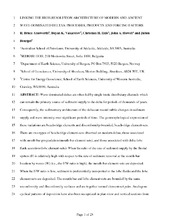| dc.contributor.author | Ainsworth, R. Bruce | |
| dc.contributor.author | Vakarelov, Boyan K. | |
| dc.contributor.author | Eide, Christian Haug | |
| dc.contributor.author | Howell, John Anthony | |
| dc.contributor.author | Bourget, Julien | |
| dc.date.accessioned | 2020-06-04T12:19:22Z | |
| dc.date.available | 2020-06-04T12:19:22Z | |
| dc.date.issued | 2019 | |
| dc.Published | Ainsworth RB, Vakarelov BK, Eide CH, Howell JA, Bourget J. Linking the high-resolution architecture of modern and ancient wave-dominated deltas: Processes, products, and forcing factors. Journal of Sedimentary Research. 2019;89(2):168–185 | eng |
| dc.identifier.issn | 1527-1404 | en_US |
| dc.identifier.issn | 1938-3681 | en_US |
| dc.identifier.uri | https://hdl.handle.net/1956/22461 | |
| dc.description.abstract | Wave-dominated deltas are often fed by single trunk distributary channels which can remain the primary source of sediment supply to the delta for periods of thousands of years. Consequently, the sedimentary architecture of the delta can record subtle changes in sediment supply and wave intensity over significant periods of time. The geomorphological expression of these variations are beach-ridge elements and disconformity-bounded, beach-ridge element sets. There are two types of beach-ridge element sets observed on modern deltas, those associated with mouth-bar progradation (mouth-bar element sets), and those associated with delta-lobe flank accretion (lobe element sets). When the ratio of the rate of sediment supply by the fluvial system (F) is relatively high with respect to the rate of sediment removal at the mouth-bar location by waves (W) (i.e., the F/W ratio is high), the mouth-bar element sets are deposited. When the F/W ratio is low, sediment is preferentially transported to the lobe flanks and the lobe element sets are deposited. The mouth-bar and lobe element sets are bounded by the same unconformity and disconformity surfaces and are together termed element-set pairs. Analogous cyclical patterns of deposition have also been recognized in plan view and vertical sections from studies of ancient wave-dominated deltas from outcrop and subsurface data (seismic, well logs, and cores). Dating of beach-ridge elements on deltas deposited in the last 6000 years (Holocene) indicate a rate of formation of individual ridges on the order of decades to one hundred years. The beach-ridge element sets and beach-ridge element-set pairs are typically formed in periods of hundreds of years. Groups of beach-ridge element sets, beach-ridge element-set pairs, and associated genetically related distributary channel deposits form individual delta lobes. The delta lobes are generated by fluvial avulsion episodes, which are autogenic events intrinsic to the fluvial deposystems, and which typically occur on the order of multiple hundreds to thousands of years. Individual beach-ridge-element formation has previously been attributed to autogenic events. We propose that centennial-scale climate cycles may provide a mechanism for generating and controlling the intra-lobe changes in F/W ratio that generate the beach-ridge element-set and beach-ridge element-set-pair morphology of wave-dominated deltas. It follows that observations of such morphologies in the ancient could potentially be used as a proxy for subtle centennial-scale climatic forcing of wave-dominated deltas through deep geological time. | en_US |
| dc.language.iso | eng | eng |
| dc.publisher | SEPM | en_US |
| dc.title | Linking the high-resolution architecture of modern and ancient wave-dominated deltas: Processes, products, and forcing factors | en_US |
| dc.type | Peer reviewed | |
| dc.type | Journal article | |
| dc.date.updated | 2019-11-26T18:59:11Z | |
| dc.description.version | acceptedVersion | en_US |
| dc.rights.holder | Copyright 2019, SEPM (Society for Sedimentary Geology) | en_US |
| dc.identifier.doi | https://doi.org/10.2110/jsr.2019.7 | |
| dc.identifier.cristin | 1715444 | |
| dc.source.journal | Journal of Sedimentary Research | |
